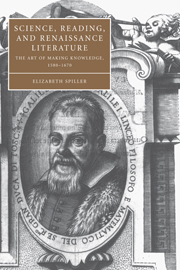Book contents
- Frontmatter
- Contents
- List of figures
- Acknowledgments
- Introduction: making early modern science and literature
- 1 Model worlds: Philip Sidney, William Gilbert, and the experiment of worldmaking
- 2 From embryology to parthenogenesis: the birth of the writer in Edmund Spenser and William Harvey
- 3 Reading through Galileo's telescope: Johannes Kepler's dream for reading knowledge
- 4 Books written of the wonders of these glasses: Thomas Hobbes, Robert Hooke, and Margaret Cavendish's theory of reading
- Afterword: fiction and the Sokal hoax
- Notes
- Index
- Cambridge Studies in Renaissance Literature and Culture
3 - Reading through Galileo's telescope: Johannes Kepler's dream for reading knowledge
Published online by Cambridge University Press: 22 September 2009
- Frontmatter
- Contents
- List of figures
- Acknowledgments
- Introduction: making early modern science and literature
- 1 Model worlds: Philip Sidney, William Gilbert, and the experiment of worldmaking
- 2 From embryology to parthenogenesis: the birth of the writer in Edmund Spenser and William Harvey
- 3 Reading through Galileo's telescope: Johannes Kepler's dream for reading knowledge
- 4 Books written of the wonders of these glasses: Thomas Hobbes, Robert Hooke, and Margaret Cavendish's theory of reading
- Afterword: fiction and the Sokal hoax
- Notes
- Index
- Cambridge Studies in Renaissance Literature and Culture
Summary
In April of 1611 Galileo demonstrated his new telescope to prominent observers at a villa outside Rome. Julius Caesar Lagalla reacted to Galileo's demonstration in a way that typified earlier responses to the innovations of the telescope: he disputed the ability of the telescope accurately to show objects on the moon, but he nonetheless enthused that the telescope made it possible to “read the letters on the gallery which Sixtus erected in the Lateran … so clearly, that we distinguished even the periods carved between the letters, at a distance of at least two miles.” In demonstrating the telescope on the Lateran palace, Galileo's intention was to show observers that this new technology ffered reliable representations of distant objects. Lagalla's unwillingness to believe Galileo's claims about the lunar observations – like the famous refusals of Guilio Libri and others even to look through the telescope – are many and complex. This incident certainly reveals new concerns about both the status of observational evidence and the reasons that observations were particularly problematic in astronomy. While allowing others to see the moon more closely, Galileo's visual demonstration could not actually carry them there. Here, however, what interests me is not so much Lagalla's unwillingness to believe what he saw of the moon as his excitement over what he saw on the Lateran. When he reads Sixtus's new inscriptions from that hilltop outside Rome, Lagalla is not using the telescope as an observational tool; instead, he is using it as a reading device.
- Type
- Chapter
- Information
- Science, Reading, and Renaissance LiteratureThe Art of Making Knowledge, 1580–1670, pp. 101 - 136Publisher: Cambridge University PressPrint publication year: 2004

